Predators on our landscape

Raccoon. Photo: Eliya, via Creative Commons, some rights reserved.
Several converging experiences over the last week got me to thinking about the role predators play in the food chain and even, it turns out, on the shape of our landscape.
It began with my hen house, led to the ridge at the top of my hay field, and ended in Yellowstone Park.
A few days ago, I mixed up the usual morning hot mash for my laying hens and headed out to the hen house. Shock of “things are not as they should be” when I opened the door. Feathers everywhere. Three dead hens, three seriously injured. And up in the rafters, an adolescent raccoon. I dumped the mash and ran to the tool shed to find something to encourage the raccoon’s immediate departure. By the time I returned, it had left on its own accord.
Human error. My error made it possible for the raccoon to attack the hens. The previous night, when I closed the hen house door after dusk, I didn’t notice the raccoon was already tucked in along the rafters. Over the course of the night, it must have played “catch the bird” with the hens. Not much sign of eating but lots of destruction.
I’ve learned over the years that the best defense against raccoon, fox and weasel attacks on hens is to have a way to secure the hen house door at night–plus metal stripping along all small openings so the weasels can’t, well, weasel their way in. While I am not opposed to the killing of a wild animal that is clearly rabid or exhibiting aggressive behavior around my house or barnyard, I really prefer to find other solutions. Live and let live (as long as the predator understands that the hens or lambs get to live, too).
The next night, I heard coyote calls over the ridge. With my sheep flock gone, I no longer worry about lamb safety, but as recently as last summer, if we had sheep pasturing out of sight of the house, in spite of the combination of permanent and moveable electric fencing, I probably would have walked to the back pasture to make sure any recently born lambs were safe. I never lost lambs to coyote, but neighbors who also raise sheep certainly have. Once again, solid fencing or night time housing can protect against predators.
Frankly, I love the call of coyote, even when it sets me worrying about predatory attacks. Of course, coyote, like most predators, are opportunistic. They go for the easy prey, feeding largely on field rodents and birds rather than domesticated animals.
The third episode in my predator musings came with a video my brother sent me. A long time activist on behalf of wolf protection, my brother has closely followed the re-introduction of wolves to Yellowstone Park and the ups and downs of their protected status. This video, shared below, is extraordinary because it explores how the wolves have had a much deeper impact on the ecology of the Park than we usually attribute to them. Yes, we all know that deer populations run out of control when humans are their only predator. We also know that uncontrolled deer populations destroy bird and other wild life habitat. But check out this video for a different take on the role of the wolf–a story of how the wolf’s impact on deer behavior has transformed the Yellowstone landscape.
After watching the video, I went down the hall to talk to our web guy Dale Hobson about sharing it with you. He reminded me that we have some extraordinary photos of north country predators taken by our listeners and web audiences–in the www.ncpr.org Photo of the Day albums.
Here are a few of my favorites:

Imprint of a Great Horned Owl that went in feet first to grab a mouse under the snow in Canton. Photo: Joshua Johnson, Bemus Point NY.
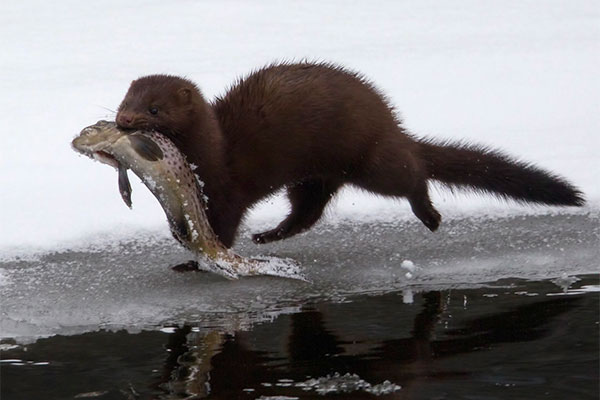
“Catch of the Day,” mink with a brown trout on the West Branch of the Ausable, Photo: Larry Master, Lake Placid
Two predators go for the easy snack: bird feeders.

A rare daytime visitor to the suet feeder–a fisher–caught on trail cam. Photo: Larry Master, Lake Placid, NY
Tags: agriculture, environment, nature, predators, wildlife





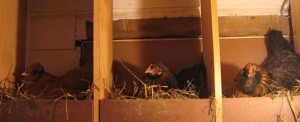
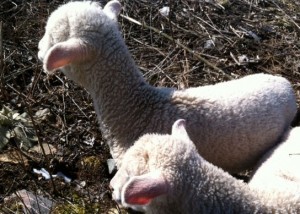
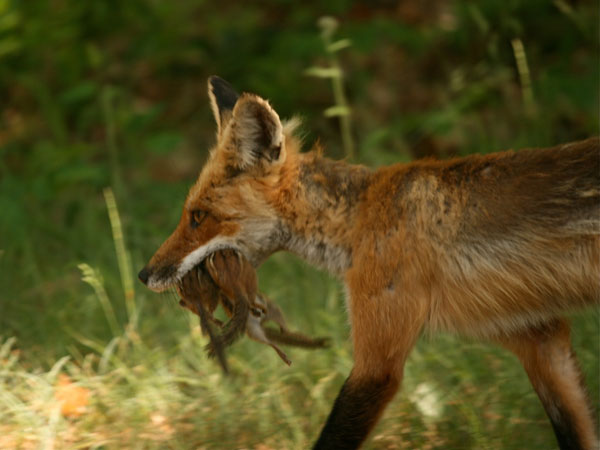
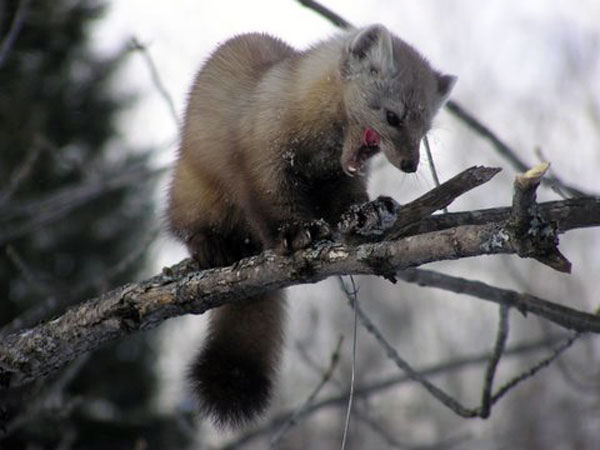



Funny, I was thinking along similar lines this morning for very different reasons. I don’t have lambs to protect but I do have a few chickens and a dog who is in guard against predators or varmints that feed on our garden. A good dog goes a long way in keeping things right at home. Ours will not tolerate a groundhog nearby and keeps rabbits in check too. A few weeks ago he killed a young fox that must have taken up an old groundhog den. It was a beautiful little fox and I buried it with a heavy heart, but the dog was doing his job.
I was reading about Lyme disease and the expansion of tick territory into the ADKs this morning then later I spent some time weeding. A little toad stayed in my way as I weeded and I tried to keep track so that I wouldn’t injure it with my weeding hoe. I’ve noticed a lot of snakes this year. It seems like last year there were lots of voles and mice. My neighbor is deathly afraid of snakes and her husband will kill them so we dont speak their name aloud if we see any.
We dont have ticks in our yard that I have seen, but not too far away over the mountain in more suburban country they are thick. I wonder if it isn’t our toads and snakes that make the difference, and a few foxes and fishers. There is no doubt things are changing around here. As a kid I never saw a bluebird or a fisher or a tick. I see bluebirds all the time now and sometimes a fisher and often a tick. Deer werent very plentiful some decades back, and very few raptors of any kind. Now we have black headed vultures, something new.
I apologize for rambling. It is just that all of this is turning round in my head. Things are changing for the better and for the worse. I cant help but feel that if I do my little part I can make my own little piece more like it ought to be.
The top predator is, of course, us.
My only hassle with wildlife is a deer who expects me to put out the birdseed in a location where it can chow down on it.
The other day when watering some flowers, it came within 20 feet of me and stared at me with a look I can only describe as “Where is my food? What have you done with it?”
this spring i began a methodical removal of chipmunks (probably a dozen relocated) and i continue to run the indoor trapline (mice and etc). i borrowed a second live trap for woodchucks. three were captured. these critters are in my house or around my house, as in on my back stoop. i found a coyote scat about 10 feet from the house three days ago and two nights ago a deer gave her alarm call under my bedroom window. ticks yes, and more critters than ever before. changes.